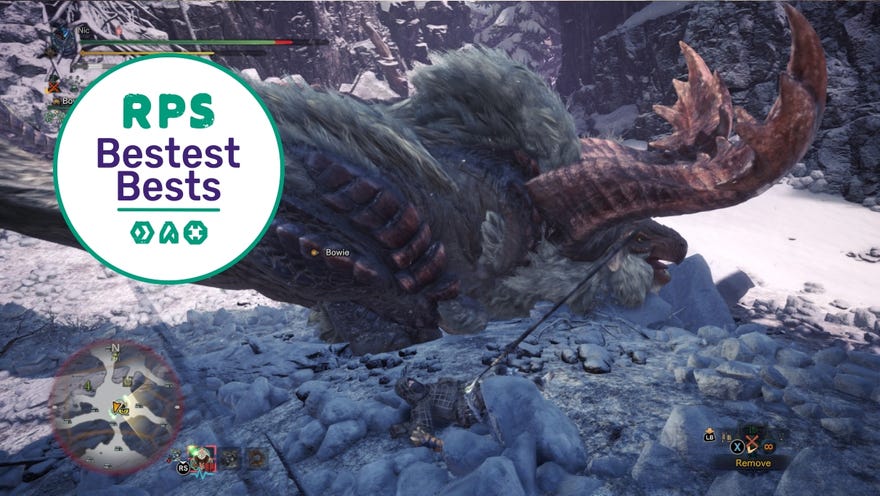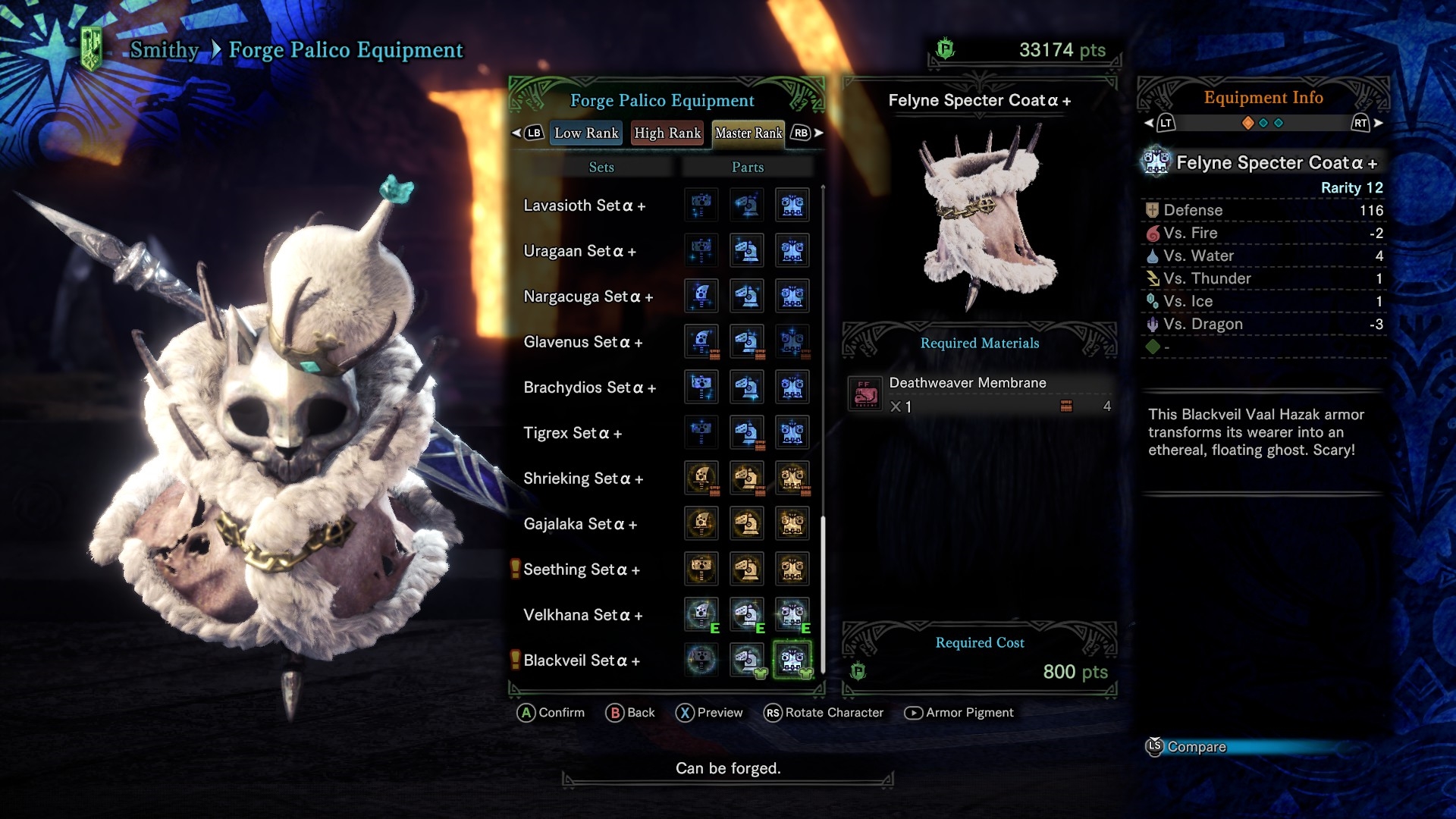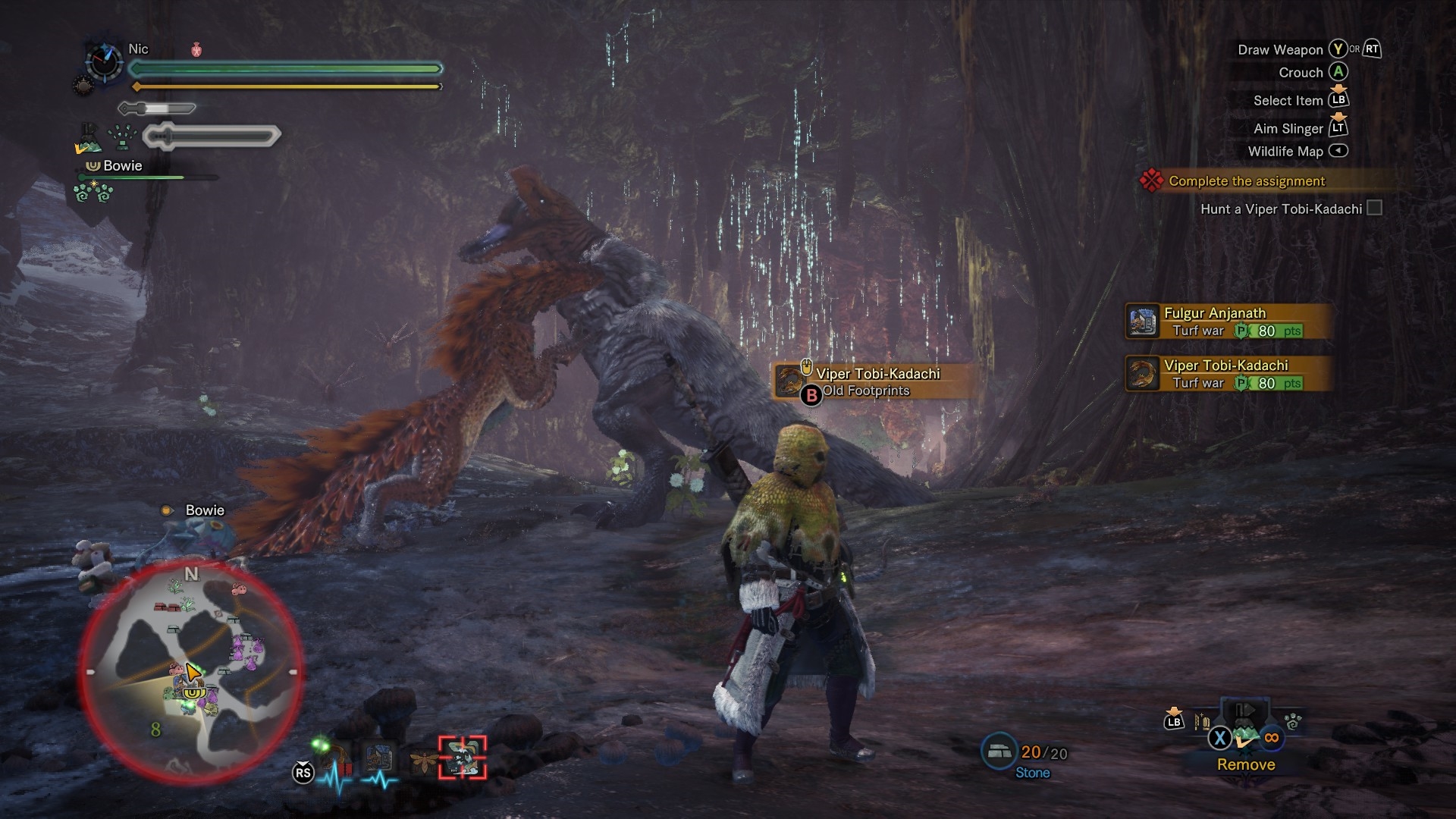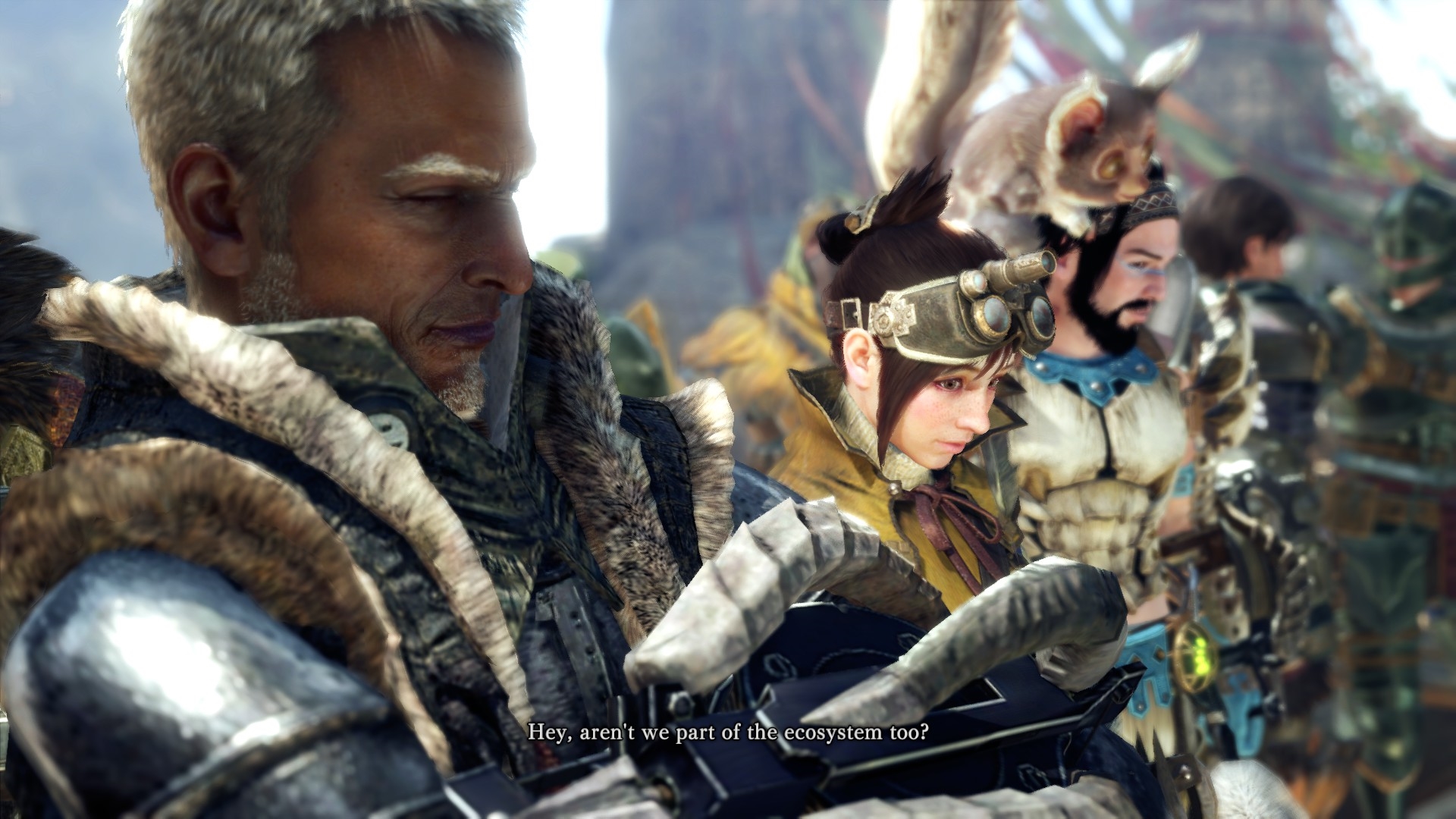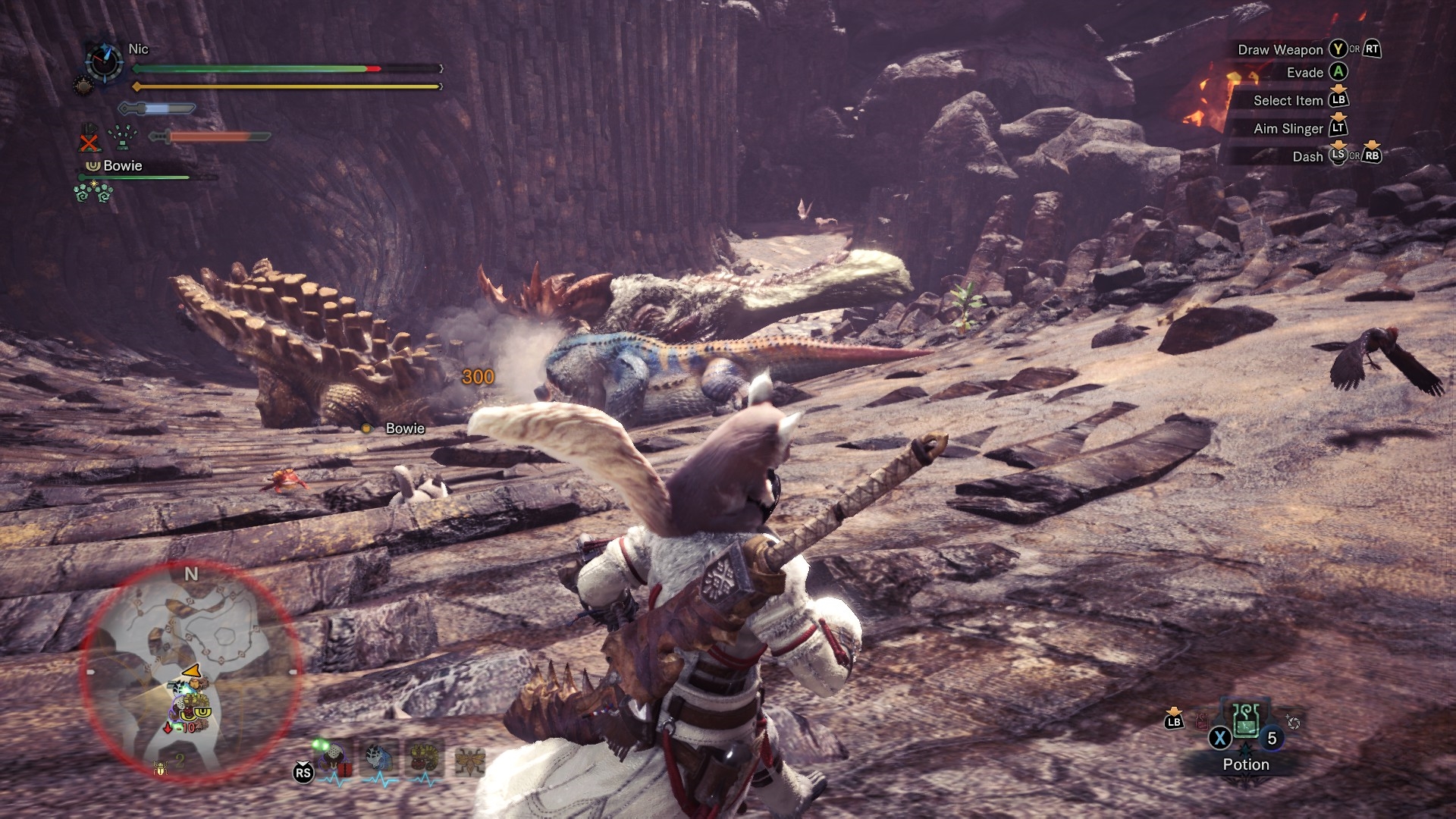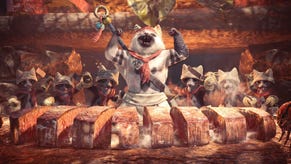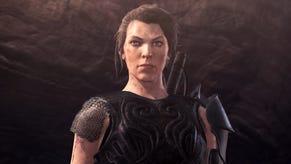Wot I Think - Monster Hunter World: Iceborne
Bestest Beasts
First things first: you need to be Hunter Rank 16 to access Monster Hunter World: Iceborne, which basically means you need to have beaten the base game’s final story boss before you pick it up. I know this is an incredibly dry way to start, but I asked myself what the first thing I’d hope to learn from an Iceborne review would be, and that was it. So there you are. Never say I am not here for you.
Right, then, let’s try again. For the uninitiated: Monster Hunter World is a third-person boss-rush game, styled as a shounen anime nature documentary about komodo dragons the size of buses. You hunt a big lizard over one of several open-ish world maps, kill it, turn it into a pair of studded jorts and a giant bone hammer, and then use them to kill a bigger lizard. In this fashion, you work your way up the food chain from dreadlocked iguanas to majestic, deadly dragons. You can do it solo with an adorable cat companion called a Palico, or you can do it online with up to three other players, tooled up with complimentary builds like in an MMO raid. It’s exceptionally beautiful and enormously deep - and it’s silly amounts of fun, so long as you don’t think too hard about what it's saying about the relationship between humans and nature. I reviewed it here.
As an expansion, Iceborne feels almost obscenely generous with new stuff - and I say that in full consideration of the fact Capcom frequently add monst (noun, plural noun: some monsters) as impressive as the better Sekiro bosses to the game, completely for free. Iceborne is the best kind of expansion: one which incorporates and uplifts, rather than supersedes, the original material. It doesn’t just leave the old monst to rot: it makes them stronger, and relevant again.
See that cat in the picture? The one dressed as a baker, making dough for bread in the new hub area? That’s Capcom, that is, kneading Iceborne into the base game. Look at her tiny, industrious paws. She is more than a baker. She is one with the loaf. Similarly, Iceborne is masterfully blended with Monster Hunter World, making it an easy recommendation for anyone who enjoyed the original. There is one caveat: it assumes you’ll spend at least some time getting into the new meta, focusing on builds, weaknessness, buffs, and debuffs. If you don’t, you’re in for a shock, as the third new monster you’ll fight is easily tougher than the previous end boss.
Here’s a laundry list of new features. Gather it up in your arms and take a big whiff of that icy funk. There are 27 new large monst, 13 of which are variants of older monst - for example, the venomous, winged Viper Tobi-Kadachi. Of the remaining 14 large monst, 3 are variants of the new ones - so there’s both a fiery variant of the tail-smashing Glavenus, and an acidic counterpart. On top of this, all the old monst can be faced on the new Master Rank difficulty level, and there are new armour and weapon items for each of them.
There’s a new frozen locale, Hoarfrost Reach, and a new hub in the snow-quilted, homely Seliana. There’s also a new endgame area called The Guiding Lands, which I won’t spoil, except to say that it’s likely to add a good few hundred extra hours of play for the most dedicated hunters, on top of Iceborne’s 40-hour story.
Because of the cold, presumably, there’s now the option to craft layered armour, which lets you style your old garb differently, while keeping its stats. There’s at least one new move for each of the 14 weapons. There are some new minigames - a guessing-game slot machine themed around creating steam to power your new hub, and a game that essentially amounts to Palico Pokémon Snap. There are decorations and furniture items to collect from your room, some of which can be unlocked through Iceborne’s dozens of new sidequests. And there’s a whole new way to befriend and interact with the smaller monsters in each locale.
All of these changes affect the size of Monster Hunter World, bulking it up from a not-inconsiderable Flintstones turkey leg to a genetically-engineered Kaiju turducken. But the most significant change to how the game actually plays is a wrist-mounted grappling hook called the Clutch Claw. Let’s discuss the Clutch Claw.
The Clutch Claw is versatile enough that it’s worth booking up on (using, for example, Dave’s guides). Very broadly though, it gives every hunter the option to grapple onto monst, weakening body parts and potentially launching a volley of slinger ammo into their eyes, which makes them crash into walls for a meaty chunk of damage and a knockdown.
Opportunities to achieve this (perhaps slightly unbalanced) move become scarcer the higher up the food chain you hunt, while enraged monst are immune, and so likely to buck you off instantly. Used sparingly and skilfully, however, the Claw makes for a satisfying spectacle, that grants some much-needed moments of reprieve in the early fights, before you’ve utterly broken your majestic quarry's will to live. It’s good, and I like it, but the temptation to overuse it does mean a new learning curve for hunters already comfortable with their chosen move sets.
A consistent joy of Iceborne is how bright and jolly the new spaces feel, given that they are, conceptually, stock vidyagame ice zones to compliment the forest, poison, fire and crystal zones from the base game. In execution, though, they feel more like living snowglobes than inhospitable tundra. Hoarfrost Reach teems with fragile beauty: all crystalline ice jaggies, diamond-dusted shrubs and bubbling hot springs, populated by wide-eyed lemurs and laced with sparkling, stalactite-mawed caverns.
The new hub is more compact and easy to navigate than the old, and the wistful optimism of the Gaelic, piratey, slightly Christmassy music there makes a nice change from Astera’s bombastic, gung-ho trumpetbastardry. They’re both a pleasure to spend time in. If there’s one thing Monster Hunter World excelled at, it’s reminding you how much it loved the natural world, even while rewarding you for plundering it. We’ll talk about that in a moment, but it’s fair to say Iceborne builds on this with exuberant care and craftsmanship.
Iceborne’s set dressing isn’t just for show, either. Hoarfrost Reach plays host to its own variety of flora, fauna, ingredients, and hazards. As a counterpart to the Cool Drinks you needed to quaff to protect against the lava area in Elder’s Recess, Hoarfrost has you snatching up fistfuls of hot peppers for spicy soup, to ward against the stamina-draining chill. Or, you can just go play with the lemurs in the hot springs, and get a bit of health regen while you’re at it. Plus, you can grab a lemur or two to keep as pets. Or, uh, you can wear one on your head, alive and everything. Long-rangers or Insect Glaive wielders can drop hanging stalactites onto the heads of foolish monst for massive stun damage, while you can ride icy water geysers into the air for the elevation needed to perform jump attacks. I call them diamond geysers, which I assume they enjoy.
Here, have a complaint, straight out of left field (which is the field in which complaints are grown). The size, power, and health pools of the new monst can often accentuate one of Iceborne’s most noticeable flaws, which is how incredibly exhausting it can be. While you’re still learning the ropes, and especially while playing solo, you can easily end up fighting the same monster for what feels like an age. The turf wars between two large monst fighting for territory remain an impressive spectacle, but when absent-mindedly grinding for parts, having to deal with an enraged, pickled-godzilla Deviljho and a bomb-shitting Bazelgeuse alongside your target can get a bit much.
This exhaustion can feel resonant, sometimes. The art, AI, animation, and score all work together to convince you that anything less than an exhausting deadlock wouldn’t do these incredible beasts justice. It doesn’t feel right, then, that you should be able to fell these behemoths without breaking a sweat. Then again, despite Iceborne’s bestiary including some of the more outwardly hostile creature designs in the series, it often doesn’t feel right anyway.
Time and distance has, I’ll admit, numbed me to the guilt inherent in Monster Hunter World’s joys. It’s easy to get drawn in by the eccentric optimism, the sound and fury, and the pure lizard brain pleasures of brained lizard treasures. It’s easy to drown out that little voice inside you that’s fully aware of how dissonantly uncomfortable the central conceit here is. But uncomfortable it is.
Iceborne was a chance to explore the implications of the game’s core adversarial relationship: one between a humanity presented as ever-plucky and heroic, and the natural world you’re consistently rewarded for looting and conquering. A chance to offer a glimpse of a future for the game’s world that works towards symbiosis with, rather than mastery of, the natural world it so clearly cherishes. Iceborne isn’t this.
It’s entirely possible that if Monster Hunter World had, say, a tenth of the production values and care invested in it, it wouldn’t feel so uncomfortable to play sometimes. We’ve emptied buckshot into crudely pixelated attack dogs for decades now, after all. Perhaps it’s only how uncannily convincing these creatures and environments are that gives Monster Hunter the impression of being any more callous than say, Duck Hunt? Would those roars of pain cut quite so deep in 16 bit? It is, perhaps, a critique rooted in the game’s embarrassment of riches.
I can’t help but think of Final Fantasy 14’s Heavensward expansion, which painted its war between humans and dragons in shades of grey, and interrogated the gung-ho heroism of its would-be noble monster slayers. Monster Hunter does have lore, if you go looking for it, that justifies the hunter’s actions as striving for ‘balance in nature’. Although, funnily enough, achieving that balance never seems to come at the cost of human expansion. Still, if I spend 99 hours slaughtering previously-dormant lizards for material gain, and one hour having the noble reasons for the slaughter explained to me, that one hour of story is hardly what the game is about.
To put on a point on all this: Iceborne adds more greatness to an already great game - but it would be damn near perfect if I could take the plight of its characters seriously, or empathise with their goals without compartmentalising to the extent that I am more or less numb to the story it tells.
This isn’t entirely Capcom’s fault. A team that wasn’t so reverent of the natural world could never have created such an enchanting homage to it. If they’ve offered us a vision of Eden, then compulsive acquisition and contrived conflict are gaming’s original sins. But, hey, this is just me thinking. Obviously I don’t believe enjoying the game makes you, reader, a heartless gecko kicker. The gecko brains on your boot do that just fine.
Still, Iceborne is a remarkable achievement. I’m slapping the Bestest Best sticker on it, and not just to make up for the fact that I erroneously didn’t slap it on the base game. Together, they form a standout work that excels at everything it sets out to do, with the exception of storytelling. Iceborne adds even more joyful oddness to what is, perhaps, the most idiosyncratic and whimsical of recent graphical benchmark blockbusters. It boasts the sort of production values that seem antithetical to risk taking, while remaining a deceptively vast and information-rich game, that places an easy thousand hours between instant enjoyment and eventual mastery.
Iceborne is an essential expansion for a game that is paradoxically both enormous and niche. I’d recommend it to everyone - even if only because it’s likely to convert a few of you to veganism.
